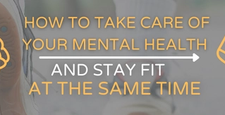5 Slow and Steady Tips to Reach Your Fitness Goals

Slow and steady wins the race is an age old saying from the fable of the tortoise and the hare. The story is about a tortoise and rabbit that engage in a race and surprisingly the tortoise wins; but he didn’t win with speed, he won with persistence. The moral of the story is that consistency is more important to reaching your goals than working too hard and burning yourself out.
True health, fitness or weight loss requires lifestyle changes for long-term success. For example, a short-term fad diet may help you jump start weight loss, but if you truly want to look and feel your best and achieve lasting results, it’s best to use the slow and steady mentality. Persistence pays off, and going at a steady pace will help you get there.
When beginning a new fitness routine or trying to reach a new goal, do not try to accomplish everything at once. Incorporate a sensible diet and consistent exercise routine that you can stick with. This attitude will help you change your behavior and embrace a fitness lifestyle that lasts. Fad diets rarely result in permanent weight loss, and you cannot train for a marathon in a week. These things simply take time. The great thing about being apart of Yes.Fit is you can go at your own pace. But don’t worry, you will see results of progress even before you get there. The great thing about being apart of Yes.Fit is you can go at your own pace.
Your progress might show up as weight loss, a lower resting heart rate or making it through an entire HITT class. To mark your progress, keep a journal of sports activities or your fitness plan, and you will see yourself moving toward your goals. This activity becomes a positive cycle as you watch yourself slowly and steadily getting stronger and healthier, which will motivate you to keep on going. Here are some more ways to help you continue to move forward, slow and steady, so you can win your personal race.
Try a HIIT Workout
HIIT stands for High Intensity Interval Training, and is considered by many to be a quick way to burn fat, lose weight and shape up. This type of class can help you keep your workout sessions to a minimum and still works with our slow and steady plan; here’s why…
This type of workout offers fat-burning and muscle strengthening benefits in just 10-30 minutes, with two or three sessions a week. You get the same benefits as a moderate intensity workout in twice that amount of time, meaning less time with more results. Spending less time in a workout makes it easier to fit in your schedule and is easier to remain consistent.
But that doesn’t mean you should jump into a class and go full force, and here’s where the slow part of the equation fits in. Due to the fast-paced nature of this type of workout, you can risk injury or burnout if you don’t train properly. Start slowly with the guidance of a personal trainer or find a class for beginners at your gym or online. It’s better to begin slowly with less reps and get the exercises right before you go full speed; which brings us to the next tip.
Begin Slowly
Starting slowly is imperative to ensure you will continue to work out at a steady pace. All too often, people begin a new fitness routine by doing too much. This is often because they are new to exercising and have no injuries or sore muscles, yet. But this can quickly change if you don’t pay attention and try to do too much.
Moving too fast through a workout can cause you to use poor form, resulting in injury. It can also lead to over training, resulting in extreme muscle soreness with a slow recovery time. This can be discouraging for anyone at the beginning of a fitness program. Instead, research what a personal trainer would recommend for someone at your fitness level and stick to it. You’ll get to your goal quicker than you think.
Learn the Technique
Whether you do a HIIT workout or any other kind, learn the proper technique. Good form and technique help you avoid injury and build muscle in all the right places. This helps you remain strong and balanced, and in the long run you will make better progress.
Each exercise has an ideal technique that lowers the risk for injury. A teacher will demonstrate the right technique in an exercise class, or a personal trainer can help you in other sports like weight training. Even running and walking have specific techniques that strengthens muscles in a balanced way, to help protect your knees, hips and feet. Do not bypass good form just to get in more reps or distance, or you could be asking for trouble.
Mind Body Connection
Learning the right technique for your workout can help you avoid injury and soreness, but it can do more than that. To keep the right form during an exercise, you have to pay attention to the muscle, which creates a connection from your mind to your body. But why is this important?
Studies show that during exercise, focusing on the muscle being used increased the activity and strength of the muscle more than without focus. (1) In other words, the muscles get stronger, faster. Other studies divided people into groups of those that used “high mental effort” during a low-intensity workout and a control group who did not. The group that focused had significantly increased muscle strength compared to the control group. These studies show you can get great results by taking it a little easier, and this is great news for those who decide to take it slow and steady!
Recover and Rest
Don’t forget to add a recovery day at least one to three days a week. Muscle tissues repair when the body is at rest, so down-time is just as important as the workout days. Use your days off to eat healthy and help your muscles recover and build. Take a slow walk if you really need to move. But keep in mind that one to three days of rest each week will help you see better results.
Remaining consistent in your workout and diet are always the best way to reach a goal. And remember, the amount of time you spend is not as important as the quality. Moving towards your goals using a slow and steady approach is a way to ensure you stick with it.
References:
1 Calatayud, J., Vinstrup, J., Jakobsen, M. D., Sundstrup, E., Brandt, M., Jay, K., . . . Andersen, L. L. (2016, March). Importance of mind-muscle connection during progressive resistance training. Retrieved August 8, 2019, from https://www.ncbi.nlm.nih.gov/pubmed/26700744



















